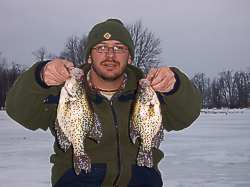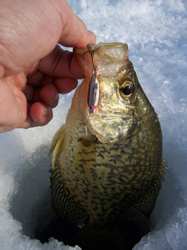|
"Capitalizing On Those Winter Crappies" By
Justin Hoffman

Justin displays some true slabs of the hard water. These were
both suspending fish that were located well off of bottom.
Crunch time has arrived for the ice-angling enthusiasts. With the
walleye season shutting down shop across many of the lakes in
Ontario, we can finally put all of our attention and effort into
icing some slab crappies, at least for the next few weeks or so.
Crappie are my favourite specie to target through the ice - they
make you think and adapt when targeting them, give a dandy of a
tussle on light gear, and of course, they taste scrumptious in the
pan. Follow these tips and tactics, and have fun ending the season
off in a resounding flurry of action.
Where Are They Hiding?
Crappie relate to typical areas during the winter, and for the
most part, deep water is the name of the game. Deep water can have a
different meaning for varying bodies of water, but will usually fall
between 12 and 30 feet. I prefer to start at the deepest spot and
gradually move shallower until I connect with the fish. Up here in
Ottawa, my favourite bay has me catching them out of 13 feet, but if
they are on the move, finding the first break in 9 feet of water
will get me into the thick of things. Moving around is key. Don't be
content to sit on a hole and wait for the fish to come to you. (It
could be one l-o-n-g wait!) Instead, actively search for the fish,
working your way around the lake until you hit paydirt.
Areas to keep an eye out for are points, spots adjacent to
islands, bays off of main lake areas and breaklines. I have had a
lot of success fishing sand/mud areas, especially when schools are
migrating across in search of food. This has a lot to do with the
plankton/ baitfish connection, and this is one thing they definitely
key in on at certain times.
Rigging and Jigging
Jigging for crappie is my favourite technique to target these
fish with. There's something about a……lift…..pause…..SMACK to really
get the adrenaline pumping. But in order to catch these guys, you
need to be using the right gear.
Ultra light or noodle rods are the way to go. If you can't feel
the weight or action of the tiny lure you're offering, you're in for
a tough time on the ice. Line is another critical consideration. Two
to four-pound test is the maximum you need to go. This may seem
light, but it is necessary for working such small lures. The lighter
your line, the more action you can impart to your lure, as well as
being able to trick these 'line-shy' fish.
As for lures, I have two favourites - a lead-head jig and a
spoon. I like to think of it as my one-two punch, and will let the
fish dictate which they prefer.
Keep your jigs smaller than the size of a dime, and your spoons no
larger than a twonie. Don't go for overkill out there - we're
certainly not after pike or walleye, so keep those oversized baits
at home.
A small jig will always be a winner on the ice for crappie. They
will work for aggressive, neutral or inactive fish, and the tipping
options are wide-ranging. I've been experimenting with the Marmooska
jig a lot this year, and it hasn't let me down yet. My tipping of
choice has to be the Berkley Power Maggot, although the real version
of waxworms, maggots and mealies, as well as a sliver of baitfish
will also work well. Experimentation is the key, so don't be afraid
to take a variety of different baits for tipping, and see what the
fish are after. I've had days on the hard stuff when a Power Maggot
or plastic trailer wouldn't get a second look, but the minute I
switched to a bit of fish-flesh, the crappies began to let
themselves be known. Don't ever stick to one lure or bait - unless
they are absolutely pounding it.

The Forage Minnow is an excellent spoon for targeting winter
crappie. Fish will routinely hit this bait on the pause, so always
be on the ready.
I recently picked up some Forage Minnow spoons, and I've found
them to be absolutely deadly on winter crappie, more so than most
spoons I've tried in the past. Go with the smallest version you can
find (silver has been a great hue for me) and work it with short
flicks of the wrist to bring fish in and make them strike. Nine out
of ten fish will hit this bait on the pause, so be ready for any and
all takers. The tail of a minnow has been my go-to tipping option
for spoons this season. I think a lot has to do with the profile of
the spoon (looks a lot like a minnow) and the aroma and taste of
real fish that becomes overly convincing. Keep this valuable tip in
mind next time you're out.
The one thing that spoons can do over jigs is bring fish in from
afar. The flash and action can be intriguing to a crappie, and even
if they are in a negative mood, you have at least positioned them in
your general area. If you're bringing fish in, a switch to a jig is
usually all it takes to get them to bite.
Subtle is the tactic of choice for crappie, so big, exaggerated
jigging motions are definitely out. Concentrate on making small
jiggling moves, minute lifts and drops, and quivering motions with
your wrist. In my mind, less is more when it comes to convincing
these fish.
A crappies eyes are positioned towards the top of the head,
meaning that they look upwards when feeding. This is important, as
you want to keep your presentation above their field of vision. If
your lure falls below the fish, there's less chance of them seeing
it, and of you ultimately catching them.
Crappie are notorious for suspending throughout the water column.
They can be found right on bottom, three feet up, or just under the
surface of the ice. It's imperative that you work all of the water
under you hole for optimum effectiveness. My plan of attack is to
always work the bottom first. If you're not getting bit after two or
three minutes, reel your line up a foot or so and begin to work that
depth. Give it a few more minutes, and then try higher up. Many
times you'll reach that magical depth and the action will be
immediate. Keep this in mind, and return your lure back to that hot
spot to reap the rewards.
Your Underwater Eyes
A lot has been written about the Vexilar as of late, but the fact
is, it is an invaluable tool for locating and catching more fish. It
is even more phenomenal when chasing crappies. Due to their
suspending habits, a quick look at a Vexilar will show you exactly
where they are. It will also highlight your lure on the screen,
allowing you to work those visible fish over until they strike. Many
times you can 'pull' a fish five or six feet off the bottom, but no
matter what you do, it still won't bite. When this happens, watching
the screen allows you to make slight adjustments to your
presentation, both in lure or action, ultimately convincing them to
strike. Seeing is definitely believing, and the results it can bring
to your ice fishing is positively out of this world.
Even though time is running out, there is still plenty of crappie
to be caught. Keep your presentations simple, tone down your baits
and equipment and target the areas where fish hang out. Do all of
these right, and you'll be well on your way to a few more fishful
days on the ice this season.
|